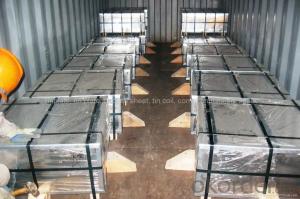Tinplate Coils for Bottom Use With High Quality
- Loading Port:
- China main port
- Payment Terms:
- TT OR LC
- Min Order Qty:
- 50 m.t
- Supply Capability:
- 1000 m.t/month
OKorder Service Pledge
OKorder Financial Service
You Might Also Like
Tinplate for Bottom Use With High Quality
1.Structure of Description
Tinplate for Bottom Use With High Quality is one of the metal packing materials, which is widely used for making painting cans ,chemical package cans , electrical cable ,battery and metal printing etc.
2. Main Features
Steady and high quality
Fast shipment
Good experience for export work
Price competitive
Good payment term
3. Images

4. Specification
Standard : GB2520-2000 ,JIS G3303
Steel type : SPCC,MR
Coating : 2.8/2.8
Surface: Bright, Stone ,
Thickness:0.31
Width :600MM~1000MM
Temper : T1~T5,DR8
Package: tinplate wrapped completely with an inner cover of plastic or waterproof papers with vorners protected with metal angels.
5.FAQ
A. What is the package of tinplate? (Referred as below)
For sheets, thin plastic film + rust-proof paper + metallic cover + metallic angles+ steel band strips + fumigated wooden pallet.
For coil, thin plastic film + rust proof paper + metallic cover + steel band strips + fumigated wooden pallet
- Q: Can tinplate packaging be used for automotive products?
- Yes, tinplate packaging can be used for automotive products. Tinplate is a versatile and durable material that provides excellent protection for automotive parts and components. It is commonly used for packaging automotive products such as lubricants, chemicals, and small parts. Tinplate packaging offers good resistance against corrosion, impact, and tampering, making it suitable for automotive industry requirements.
- Q: Can tinplate be used for electrical components?
- Yes, tinplate can be used for electrical components. Tinplate is a commonly used material in the electronics industry due to its excellent conductivity and corrosion resistance properties. It is often used for making connectors, terminals, and other electrical parts.
- Q: Why tin printing after a layer of light oil
- Varnish should have the following properties:A) the color retention property is good. The solvent in the varnish can not make the ink fade and fade.(b) have sufficient hardness and firmness in order to withstand the deformation of subsequent processes.(c) match with white paint or base oil, not to corrode white paint or base oil.
- Q: How does tinplate compare to plastic packaging in terms of sustainability?
- Tinplate generally has better sustainability credentials compared to plastic packaging. Tinplate is made from steel, which is a highly recyclable material, whereas plastic is derived from fossil fuels and has limited recycling capabilities. Tinplate can be recycled indefinitely without losing its qualities, while plastic recycling can be challenging due to different types of plastics and contamination issues. Additionally, tinplate packaging has a longer lifespan and offers better protection for products, reducing the need for excessive packaging. However, it is important to consider the overall life cycle impact, as both materials have environmental implications during production and transportation.
- Q: Can tinplate be used for packaging alcoholic beverages?
- Yes, tinplate can be used for packaging alcoholic beverages. Tinplate is a commonly used material for cans and can provide a protective barrier against external factors such as light and oxygen, ensuring the quality and freshness of the alcoholic beverages.
- Q: Can tinplate be used for non-packaging applications?
- Yes, tinplate can be used for non-packaging applications. Tinplate's corrosion resistance, durability, and versatility make it suitable for various non-packaging uses such as construction materials, automotive parts, electrical equipment, and decorative items.
- Q: How does tinplate perform in extreme temperatures?
- Tinplate generally performs well in extreme temperatures due to its high melting point and thermal conductivity. It remains stable and retains its structural integrity, making it suitable for various applications in both hot and cold environments.
- Q: What is the elongation of tinplate?
- The elongation of tinplate refers to its ability to stretch or deform under tension before it breaks. It is a measure of its ductility and is usually expressed as a percentage, representing the increase in length of the tinplate sample when pulled until it breaks.
- Q: What are the main applications of tinplate in the sports equipment industry?
- Tinplate is commonly used in the sports equipment industry for the production of metal containers, such as cans and bottles, which are utilized for packaging various sports drinks, supplements, and other products. Additionally, tinplate is employed in the manufacturing of protective coatings for certain sports equipment to enhance durability and prevent rusting or corrosion.
- Q: How does tinplate contribute to the overall reusability of packaging?
- Tinplate contributes to the overall reusability of packaging due to its durability and longevity. It can withstand multiple uses without losing its structural integrity, making it ideal for packaging that needs to be reused or recycled. Additionally, tinplate can be easily cleaned and sanitized, ensuring the safety and hygiene of the packaged contents for subsequent uses.
Send your message to us
Tinplate Coils for Bottom Use With High Quality
- Loading Port:
- China main port
- Payment Terms:
- TT OR LC
- Min Order Qty:
- 50 m.t
- Supply Capability:
- 1000 m.t/month
OKorder Service Pledge
OKorder Financial Service
Similar products
Hot products
Hot Searches
Related keywords


























